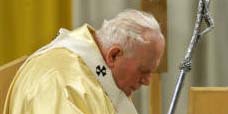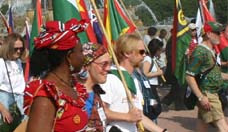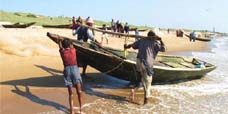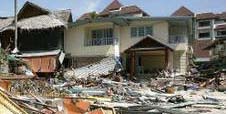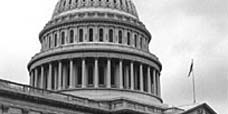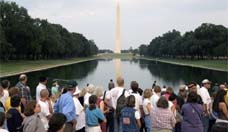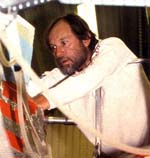
Kenya RPCV Terry Deschler sees progress in halting ozone loss
UW professor sees progress in halting ozone loss
By W. DALE NELSON
Star-Tribune correspondent Sunday, April 17, 2005
LARAMIE -- In 1988, six years out of graduate school and looking for a job, Terry Deshler called on one of his old University of Wyoming physics professors to ask him for a letter of reference.
His former mentor told him he didn't need to look any further for work. The university had received a grant from the National Science Foundation to conduct stratospheric studies in Antarctica, and he offered Deshler the job.
"That sounded like fun, so I took it on," Deshler said.
The decision led him to a career measuring the crucial role of dust, particularly aerosol particles, in depleting the ozone layer and thus increasing the risks of skin cancer and sunburn.
Deshler discussed his research in an interview in his sixth-floor office in the UW Engineering Building last week and as featured speaker in the university's 2005 President's Speaker Series. He will repeat his lecture at 7 p.m. Monday at the UW Outreach Center in Casper.
"I would say it was just serendipity that I have studied dust," he said. "It wasn't like some day I woke up and said, ‘Hey, I want to study dust.'"
Deshler came to UW as a freshman majoring in mathematics in 1965 from Kemmerer, where his father, Bill Deshler, was superintendent of the Bridger-Teton National Forest. At the university he met Barbara Cresswell, daughter of Betty Cresswell and the late Don Cresswell of Casper. They married and went to Kisii, Kenya, as Peace Corps teachers.
Deshler taught physics, chemistry and mathematics. "That is when I decided that I was more interested in science than mathematics," he said. He returned to the campus in 1992, completed his bachelor's degree in math, and went on to a master's in atmospheric science and a Ph.D. in physics.
As a graduate student, he said, his most interesting experiment was measuring ice nucleids, the particles in the atmosphere that cause droplets. After getting his doctorate, he went to California and did cloud seeding work for the Bureau of Reclamation.
He returned to Wyoming after the federal government decided not to invest further in efforts to make rain by seeding clouds with dry ice crystals or silver iodide smoke.
Causing and solving a problem
The problem he was tackling by measuring aerosol particles in Antarctica and later in the north polar region of Sweden, by use of lasers and other instruments, stemmed from a technical advance in the field of refrigeration decades earlier.
In 1928, chemist Thomas Midgley invented chlorofluorocarbides, known as CFCs, to take the place of the chemicals then used in refrigerators.
"The great thing about CFCs was that they were the first totally safe refrigeration," Deshler said. "Before 1928, if your refrigerator broke in the middle of the night, you might not wake up in the morning."
But the CFCs were also like "trucks carrying chlorine," he said. "The problem is that because of CFCs we have released enough chlorines into the lower atmosphere to expand into the stratosphere," resulting in loss of the ozone that is critical to filtering out ultraviolet light, which causes sunburn and skin cancer.
The problem is most acute in the Southern Hemisphere, Deshler said.
"Australia is the skin cancer capital of the world," he said. "Weather forecasts include how much time it will take to get sunburned. They'll say, '11 minutes to burn,' or '12 minutes to burn.'"
In 1996, industrial countries stopped producing CFCs in accord with an agreement, the Montreal Protocol of 1987, under auspices of the United Nations environmental organization. Developing countries were given a reprieve, because they were just getting refrigeration for the first time, and the newer technologies replacing the CFCs, which use hydrogen, were more costly.
Because of the Montreal Protocol, he said, "The good news is that we know what to do. The bad news is that it is going to take about 50 years. It is a positive story, because science is solving a problem created by human action. Eventually it will eliminate the problem."
The reason it will take so long, Deshler said, is that "once you release a molecule at the surface, it takes about five years for it to reach the stratosphere. It has a lifetime there of 10 to 40 years."
"As of the turn of the century, we started to see a maximum of CFCs, and they are now starting to decline," he said. "If we wait for the 1970 level, we have to wait about 20 to 50 years."
Meanwhile, at McMurdo Sound in Antarctica, Wyoming scientists join an international contingent in measuring the ozone, sending instruments into the stratosphere on platforms tethered to unmanned balloons. Wyoming sends a team of four each year, departing from Laramie in mid-August and returning at the end of October, during the Antarctic winter.
"I don't go every year," Deshler said. "I can't fulfill my responsibility to university teaching and always go to Antarctica."
The research he is involved in has "only a minimal relationship" to global warming, he said. "They are two different phenomena. Politically, maybe there is a lesson. I don't know."
The United States, which agreed to the Montreal Protocol, has balked at the international Kyoto Protocol on Global Warming, which went into effect this year with the signature of Russia.
"I see the ozone loss issue as a model" for dealing with other environmental problems, he said. "It was the very first time that an environmental problem was recognized to be a result of local activity. We came up with a plan how to solve the problem internationally."
Star-Tribune correspondent W. Dale Nelson can be reached at wdnelson@bresnan.net.
If you go...
* What: UW professor Terry Deshler speaks about his research on the crucial role of dust as part of the university's 2005 President's Speaker Series.
* When: 7 p.m. Monday.
* Where: UW Outreach Center in Casper.
* Who: The public is invited.






